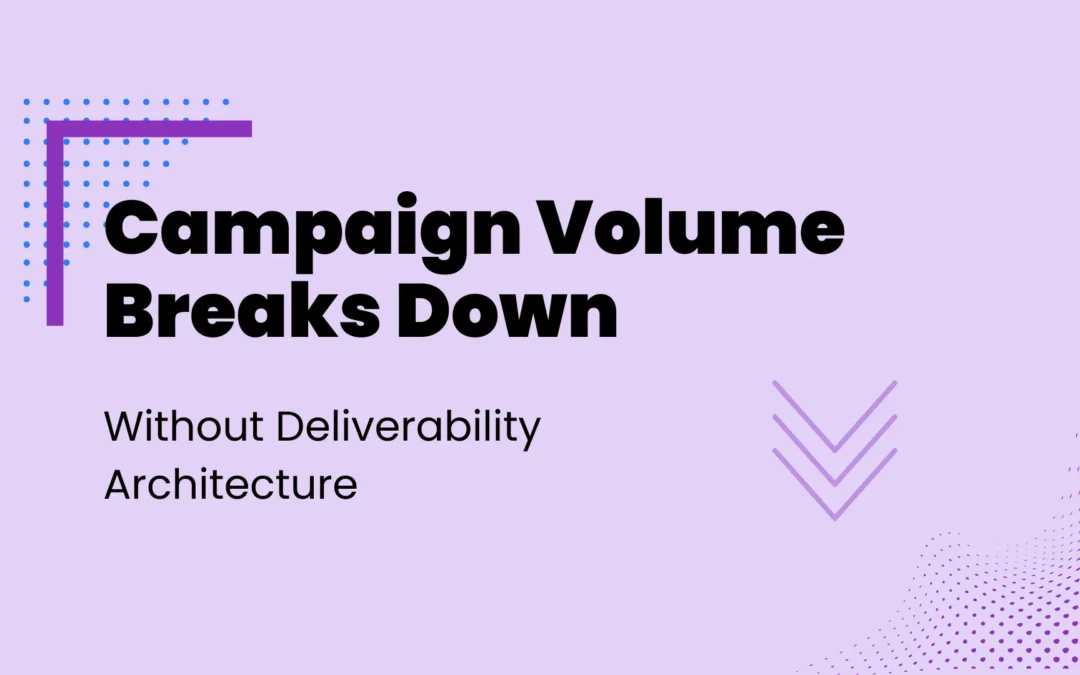Mass cold outreach means nothing if no one sees your emails. Many B2B sales campaigns break down at scale due to one hidden culprit: a weak email deliverability architecture undermining lead generation.
High Volume, Low Results: The Email Deliverability Dilemma
As campaign volume climbs, hitting the inbox becomes harder. On average, only about 1 in 4 cold sales emails is ever opened by a prospect, and poor deliverability is a big reason why. Sales teams often assume blasting more cold emails will multiply lead generation, but poor deliverability causes many messages to land in spam or get blocked.
Without the right architecture, even big sales campaigns yield disappointing results. For instance, send 10,000 cold emails without proper setup and you might discover thousands of those messages never reach a prospect’s inbox. Simply increasing volume without deliverability planning can waste most of your outreach effort instead of boosting lead generation. Additionally, savvy prospects often delete or mark mass emails as spam, further damaging sender reputation if volume is pushed without proper safeguards.
• Large email blasts trigger spam filters, meaning many prospects never even see your sales campaign in their inbox.
• Sender reputation suffers when too many emails come from one domain, lowering future deliverability for all your outreach.
• Low inbox placement quietly cuts down your pipeline because leads can’t respond to what they never received, no matter how high your email volume.
Email Deliverability Architecture: The Invisible Backbone
Deliverability architecture is the behind-the-scenes system that keeps cold email marketing running smoothly. It covers the technical setup and sending strategies that ensure emails reach inboxes. This infrastructure – from authenticated domains to scheduling – is the backbone of successful email marketing, without which campaign performance collapses.
In practice, it spans everything from setting up domain authentication and email protocols to monitoring inbox placement continuously. The recipient may only see a well-timed sales email, but a lot of engineering behind the scenes ensured it actually arrived in their inbox. Even the best sales content can fail without these systems in place, making deliverability architecture just as critical as the message itself. Without a sound infrastructure, a high-volume campaign is like a sports car with a faulty engine – it might look impressive, but it won’t finish the race.
• Manages technical factors (DNS records, sender authentication, IP reputation) to keep email deliverability high.
• Aligns sending schedules and volume with provider limits (like Gmail or Outlook) to avoid red flags.
• Protects sender reputation by keeping messages out of spam folders, so lead generation efforts aren’t wasted.
Sender Rotation, Throttling & Warm-Up: Core Tactics
Scaling a B2B email campaign safely requires specific deliverability tactics. Key methods like sender rotation, domain throttling, and mailbox warm-up ensure that increasing outreach doesn’t trigger filters. These tactics fortify your campaign’s infrastructure so growth doesn’t come at the cost of inbox placement.
If these techniques are ignored, even a great contact list and compelling copy can falter. Without rotation or warm-up, senders quickly get flagged by ISPs and even blacklisted. In short, these tactics keep your sender reputation healthy so you can connect with more prospects consistently.
For example, a B2B firm that tried sending 5,000 emails from a new domain in one day quickly found their domain blacklisted. If they had warmed up that mailbox and throttled their sends, those emails could have safely reached prospects over a longer period.
• Sender rotation spreads emails across multiple mailboxes or domains to avoid overloading one sender identity, reducing the chance any single address gets flagged.
• Domain throttling controls send rate and volume per domain, preventing sudden spikes that alarm spam filters and keeping sending patterns natural.
• Mailbox warm-up gradually builds a positive sending reputation on new email accounts before full campaigns, so ISPs trust you more when volume increases.
Automation and AI: Infrastructure Agents for Email Deliverability
Modern sales teams use automation and AI SDR platforms to manage deliverability behind the scenes. An intelligent infrastructure agent can make real-time adjustments – from rotating sender IDs to pausing sends when engagement drops. By automating these tasks, campaigns maintain email deliverability even as they scale across omnichannel outreach.
AI now helps preserve email deliverability with real-time precision and minimal risk. Email providers closely watch metrics like opens and spam complaints, so reacting to those signals quickly is key – something automation handles better than any human team.
For example, if open rates drop or bounce rates spike, an AI agent might automatically pause emails to that segment or switch to a fresh domain. This real-time control corrects issues before they damage your campaign. Essentially, the infrastructure agent acts like a guardian for your sender reputation across channels. It also prunes out invalid or unengaged addresses, preventing repeated bounces from hurting your domain reputation. These deliverability chores once demanded constant human oversight, which is tedious and error-prone. Now AI handles them as an always-on deliverability manager, ensuring nothing slips through the cracks.
• AI SDR systems dynamically adjust send times and frequency based on engagement metrics and intent data, sending each message at the optimal time.
• Infrastructure agents automate domain and sender selection for each prospect to maximize inboxing, matching each outreach with the best technical setup.
• Machine learning monitors bounces and replies, tweaking campaigns to protect sender reputation continuously – like having an expert fine-tune every send in real time.
From Deliverability to Pipeline Growth
Email remains one of the most effective B2B lead generation channels (used by over 85% of firms), which means deliverability is directly tied to pipeline success. A strong deliverability architecture directly boosts pipeline generation. When more emails reach inboxes and actually get read, cold outreach converts into warm leads. The combination of robust infrastructure, targeting driven by intent data, and personalized content allows sales development teams to scale B2B pipeline growth and lead generation.
Consider that a typical cold email campaign might only get replies from 1% of recipients – better deliverability can double or triple that rate simply by reaching more eyes. The same outbound effort yields far more leads when architecture is optimized. Some B2B teams have doubled their sales pipelines just by fixing deliverability issues. That means more pipeline for the same effort, effectively lowering the cost per lead of your outbound campaigns.
A healthy infrastructure also means you can nurture prospects through multiple follow-up emails without fear of them going to spam, maximizing your chances to convert leads over time.
• Higher inbox placement leads to more opens, replies, and ultimately more sales opportunities from the same campaign effort.
• Improved cold outreach engagement fills your sales pipeline with qualified leads for the team to work, without needing to send more emails.
• Robust infrastructure lets you scale personalized email outreach campaigns without deliverability issues holding you back, so creativity and personalization aren’t limited by technical constraints.
Conclusion
In summary, deliverability architecture has become mission-critical for high-volume sales campaign success. Without a strong sending infrastructure supporting your messaging, even the best cold emails will fall flat. In today’s B2B landscape, investing in the right architecture ensures outreach efforts translate into inbox visibility, engagement, and real pipeline results.
Optimizing Your Sales Outreach with GetReplies
Fortunately, new AI-driven sales tools now integrate these deliverability best practices. For example, GetReplies is an AI SDR platform that uses an intelligent infrastructure agent to handle tasks like sender rotation, throttling, and mailbox warm-ups. This ensures large-scale personalized outreach campaigns maintain high deliverability and consistently book more meetings.

